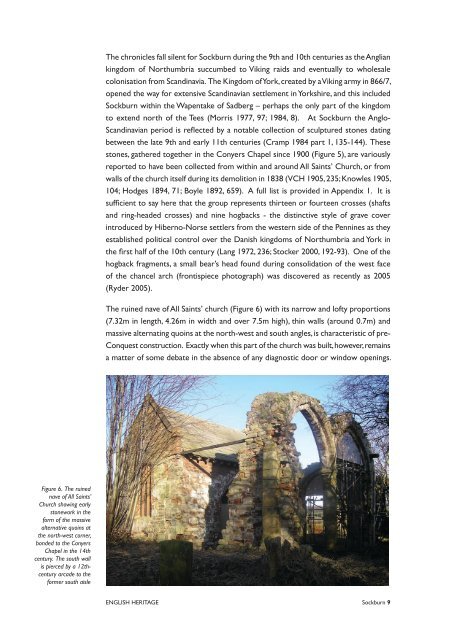Sockburn Hall, Darlington: an archaeological ... - English Heritage
Sockburn Hall, Darlington: an archaeological ... - English Heritage
Sockburn Hall, Darlington: an archaeological ... - English Heritage
You also want an ePaper? Increase the reach of your titles
YUMPU automatically turns print PDFs into web optimized ePapers that Google loves.
Figure 6. The ruined<br />
nave of All Saints’<br />
Church showing early<br />
stonework in the<br />
form of the massive<br />
alternative quoins at<br />
the north-west corner,<br />
bonded to the Conyers<br />
Chapel in the 14th<br />
century. The south wall<br />
is pierced by a 12thcentury<br />
arcade to the<br />
former south aisle<br />
The chronicles fall silent for <strong>Sockburn</strong> during the 9th <strong>an</strong>d 10th centuries as theAngli<strong>an</strong><br />
kingdom of Northumbria succumbed to Viking raids <strong>an</strong>d eventually to wholesale<br />
colonisation from Sc<strong>an</strong>dinavia. The Kingdom ofYork,created by aViking army in 866/7,<br />
opened the way for extensive Sc<strong>an</strong>dinavi<strong>an</strong> settlement inYorkshire, <strong>an</strong>d this included<br />
<strong>Sockburn</strong> within the Wapentake of Sadberg – perhaps the only part of the kingdom<br />
to extend north of the Tees (Morris 1977, 97; 1984, 8). At <strong>Sockburn</strong> the Anglo-<br />
Sc<strong>an</strong>dinavi<strong>an</strong> period is reflected by a notable collection of sculptured stones dating<br />
between the late 9th <strong>an</strong>d early 11th centuries (Cramp 1984 part 1, 135-144). These<br />
stones, gathered together in the Conyers Chapel since 1900 (Figure 5), are variously<br />
reported to have been collected from within <strong>an</strong>d around All Saints’ Church, or from<br />
walls of the church itself during its demolition in 1838 (VCH 1905,235;Knowles 1905,<br />
104; Hodges 1894, 71; Boyle 1892, 659). A full list is provided in Appendix 1. It is<br />
sufficient to say here that the group represents thirteen or fourteen crosses (shafts<br />
<strong>an</strong>d ring-headed crosses) <strong>an</strong>d nine hogbacks - the distinctive style of grave cover<br />
introduced by Hiberno-Norse settlers from the western side of the Pennines as they<br />
established political control over the D<strong>an</strong>ish kingdoms of Northumbria <strong>an</strong>d York in<br />
the first half of the 10th century (L<strong>an</strong>g 1972, 236; Stocker 2000, 192-93). One of the<br />
hogback fragments, a small bear’s head found during consolidation of the west face<br />
of the ch<strong>an</strong>cel arch (frontispiece photograph) was discovered as recently as 2005<br />
(Ryder 2005).<br />
The ruined nave of All Saints’ church (Figure 6) with its narrow <strong>an</strong>d lofty proportions<br />
(7.32m in length, 4.26m in width <strong>an</strong>d over 7.5m high), thin walls (around 0.7m) <strong>an</strong>d<br />
massive alternating quoins at the north-west <strong>an</strong>d south <strong>an</strong>gles,is characteristic of pre-<br />
Conquest construction. Exactly when this part of the church was built,however,remains<br />
a matter of some debate in the absence of <strong>an</strong>y diagnostic door or window openings.<br />
ENGLISH HERITAGE <strong>Sockburn</strong>

















